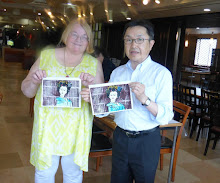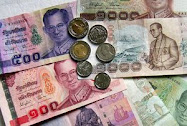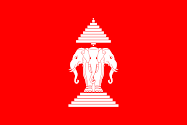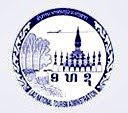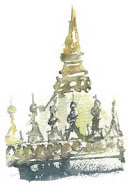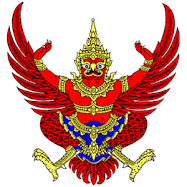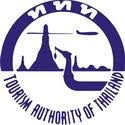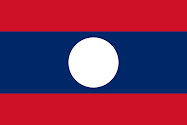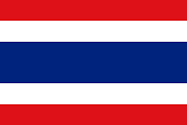Above: Train ticket
I picked up my pre-paid ticket in front of the information window. As you can see, it shows the departure and destination points, in this case, Bangkok to Chiang Mai. In the row beneath reading from the left - the train number, date, departure time and arrival time followed by the class, car and seat number and price:
Train 13, for the 10 February 2011 departing 19.35 arriving 9.45, 2nd class, lower berth, car 5, seat 22 @ 881 baht.
On the lower left hand side is Your Name, while on the lower right-hand side is the date and time of purchase.
Above: Railway staff
It was just after 6.00pm, the national anthem had finished playing and these two gents were very happy to have their photo taken. They check tickets, help with information and see that everything is running smoothly
Above: Train 13 - Bangkok to Chiang Mai
It was just as well I happened to check the board near the entrance on the concourse for the train was departing from a different platform to what was showing elsewhere - platform 3. Lucky for me eh? Otherwise I'd have been still waiting in Bangkok while my train sped off into the night.
The blue carriage was the one I was in and the purple one was first class.
Above: 2nd class air-con sleepers - modern type
Train 13 Bangkok to Chiang Mai have very comfortable air-conditioned sleepers. They are arranged in door-less compartments and each berth has its own curtains for privacy. The other three occupants all wanted to lie down and sleep - how come I always get the ones who want to go to bed early?
The train had comfy velour seating, the other ladies said this train was "new" but they liked the older trains better. I can see why - there's nowhere to put your luggage and the beds are so narrow even Twiggy would have had a hard time trying to sleep and not fall out! Try lying on a narrow space with a girth that is on the large side. Fun and games. It was fun though and I'd gladly do it again.
The lady in the berth above me wanted to lie down and read, the other two were on the way to a gentle snore and me - I made my way down to the dining car.
Above: The restaurant car
The dining car was fun - I was expected to buy something for the privilege of sitting there and smoking. (I asked the lady in charge at Hualumphong station about smoking, she told me "You can smoke in the dining car and in the toilets!")
The more popular trains have a restaurant car, some are air-conditioned but ours wasn't. I was glad it was not air-conditioned - you could open the windows and look out.
Above: Sláinte
Cheers! Over the teeth, past the gums, look out stomach, here it comes.
The food was relatively cheap. The "menu" is a leaflet with pictures of food and Thai & English writing. They also sell beer, wine, tea and coffee.
Above: Wine - it's SPY
This is the wine sold onboard, well....what pretends to be wine. Lolly water, not unpleasant by a long shot, just very...lolly waterish - you could down ten bottles and still feel no alcoholic effect.
A young French chap came and joined me and we chatted about this and that and talked travel. He was with his girlfriend he said, but she didn't want to join him in the dining car, she just wanted to lie down. Every now and then he went back to check on her but preferred to sit, drink and talk.
Above: Um...what is it?
The French bloke had come back while I was eating this and asked me what it was. I wasn't sure, the menu said it was chicken, it was supposed to be chicken. We both agreed it didn't look like any chicken we'd ever seen. Those white glutinous blobs had the texture of rubber and were un-biteable. We had great fun dissecting technically what this flubber could be!
Above: American rice
Dinner was forgettable. Don't ever order American Rice, it's nothing like Chinese fried rice which is what I had been expecting, instead you get this rice, flavoured with tomato sauce with bits of carrot in it topped with seven raisins (I counted them), a greasy fried egg, a triangle of sandwich ham and some sort of mini hot dog. I felt like I'd eaten a tub of lard. Needless to say, most of it was left on the plate.
Above: The Rookie and the Teacher
The young fellow in the yellow shirt sat down opposite me - he's a police cadet. I was joined by five coppers (transit police) and one girlfriend. They had removed the top half of their uniforms and had on white singlets, plus their trews and police paraphernalia around their waists. They were great fun.
One was a trainee, and one was from Laos - his name was Ray and he kept showing off and flexing his muscles. The beer flowed (I stuck to the lolly water) and a good time was had by all.
Above: Transit Police
A group photo. We had a lot of fun, and I really enjoyed the train, the atmosphere and people. Much more fun than train travel back home - here nobody worries about what they look like, or making noise. It's raucous and loud and noisy and really a whole lot of fun.
Above: Railway stations
It really is better having a dining car without air-con - you an stick your head out the window when it stops and you get a great view of the stations. Here is
Ayutthaya and Don Muang station.
The next day
I woke up the next morning and it was bloody freezing!
Above: Early morning to Chiang Mai
Everyone else had thick tops and jumpers on. It was 10°C. As the darkness gave way to daylight, I saw wonderful scenery and was very glad the 18.10 train had been sold out. Getting the later one enabled me to really see the beauty of the country side. Those majestic mountains with mist swirling around like a mysterious phantasmagoria.
These photos were all taken from the dining car and let me tell you sticking half your body out the window for a snap going through the mountains at 10° took a bit of doing. The pics might be a little blurry but they are the memories I carry with me of that early morning ride.
Above: Dining Car on Train 13 - Breakfast
Breakfast was a very busy time. Firstly, there were all the hot drinks - so many wanted hot coffee, hot tea, I drank several cups of hot stuff (helps to warm you up), for food, I stuck with two pieces of toast, orange juice and tea. Food was a long time coming I remember - the staff were run off their feet. It can't be easy providing meals to a few hundred people, and don't forget, most of the passengers were in their carriages, so there's lots of meals to be taken to them. They really did do a magnificent job.
Above: Countryside
Daylight had broken, the temperature had risen and there were lots of interesting things to see. I love photos of train carriages going around a bend - if you look at the photo top right-hand side you can see six cars plus the engine. The water on the left side - is it a river, a trickle of a lake or what?
The wee doggie was standing on the tracks quite unconcerned at the train whizzing past.
The train arrived at Chiang Mai on time - 2 hours late as usual but no-one minds, after all, TiT This is Thailand where the trains depart on time (usually) and arrive late (always)!☺
Thailand Time
Click On Your Flag To Translate
Thailand and Laos (and Myanmar if I can manage it)
Hello, Sawatdee kaa and Sabai dee,
My next trip will be Thailand and Laos, and this is all about the before, the trip and the after - similar to my Malaysia/Cambodia blog. I am putting together from start to finish - tickets, do's and don'ts, tours, where to stay, places to see, things to do, as well as useful extras like transport, good places to eat, what to wear, climate, tourist traps, tricks and tips and whatever else I can think of that will be useful.
If you have any tips or advice, please, feel free to leave a comment and add your bit - whatever you think may be helpful or interesting.
Cheers.
My next trip will be Thailand and Laos, and this is all about the before, the trip and the after - similar to my Malaysia/Cambodia blog. I am putting together from start to finish - tickets, do's and don'ts, tours, where to stay, places to see, things to do, as well as useful extras like transport, good places to eat, what to wear, climate, tourist traps, tricks and tips and whatever else I can think of that will be useful.
If you have any tips or advice, please, feel free to leave a comment and add your bit - whatever you think may be helpful or interesting.
Cheers.
Thailand map
View Bangkok Thailand in a larger map
Playlist - My Travel Videos
Tuesday, August 30, 2011
Sunday, August 28, 2011
61. Hua Lumphong Station
Above: My tuk-tuk driver
I just realised I should've put this photo in my previous post - he was my tuk-tuk driver in Kanchanaburi on the morning of my last day, but .... ah well, he's here now and so here he'll stay!
The road back to Bangkok
After being driven back to my guesthouse, I waited around a bit near reception for the driver of the mini-bus that was to take me back to Bangkok. For some reason, I didn't take a photo on that journey. I'm not sure why, but I do remember we stopped along the way while the driver filled the tank up with petrol, and we had a bit of time (not much) to go to the loo, grab a coffee, have a smoke or get a bite to eat.
Only I spoke with the driver, apart from three Thai passengers (the driver was Thai) and I remember thinking why don't any of the other passengers (read farfangs) speak with him too. They were a miserable lot - I've seen more life in a corpse compared to that lot of passengers!
Hua Lamphong Station
The driver dropped me off in Bangkok and said I'd need to get a taxi to the station as he didn't go there. Caught a taxi - 65 baht - and arrived at Hua Lamphong Station. It was pretty hot but not unpleasant. Spent the time taking photos and learning my way around the station.
Left Luggage
After asking a few people, I found the place where you can store your luggage - as you go through the entrance, turn right, walk along and it's right down the end. There's a staffed luggage office which is open from around 4am until 11pm daily. Price was 100 baht for the suitcase and 50 baht for the small hold-all. You get given a ticket with a number - hang on to your ticket, you won't be able to collect your luggage without it.
Above: Hua Lumphong Station
The concourse inside Bangkok Hua Lamphong Station is massive and when I say massive, I mean m.a.s.s.i.v.e - it's huuuuge. So many people, here, there and everywhere. People sitting on seats, people in groups, people talking, laughing, waiting. There was so much life and movement here.
Above: Wall murals
Up high on the walls above the sides are these fantastic murals - a kaleidoscope of colours and pictures. Some very talented artists indeed. And so beautifully executed. A mish-mash, a meandering mixture of marvellous, melodramatic images.
Above: King Rama V
The King's picture hangs above the entrance to the platforms and every day at 8.00am and 6.00pm, the national anthem is played and everyone stands to attention. I knew of this before I went to Thailand and so I, too, stood still at 6pm.
A bit of trivia
King Rama V (reigned 1868-1910) - layed the foundation of the modern Thai state, and is known as the father of Thai railways because he expanded the rail network nationwide.
Above: Leafy garden and greenery
There are plants and lots of greenery near each of the platforms - what a brilliant idea. They look quite charming amid the modern steel of technology and give the place a relaxing air.
Above: Platform 9¾
As soon as I stood here, I felt the urge to walk up to a railway staffer and ask (in an English accent), "Excuse me, can you tell me where Platform 9 and 3 quarters is please?" !
Yes, I saw Harry Potter and that scene always sticks in my memory when he asks that same question and the railway porter answers, "Platform 9 and 3 quarters? Think you're being funny do yer?"
Above: Pink Taxis
I bought Chinese noodles for 25 baht - noticed the bowl was half full yet Thai people got a full bowl. Met a lady called Carol and we struck up a conversation. It was the accent you see - you can tell an Aussie a mile away. She was from Sydney and we had coffee. I had iced coffee (65 baht) and very welcome it was too.
Outside, there are many taxis in all colours of the rainbow - ever seen a pink taxi? No? Well neither had I until I came to Bangkok. What the blokes would say back home I've no idea, but I get a smile on my face thinking of your true Aussie bloke getting into a pink taxi!
Above: Entrance to Hua Lamphong Station
Finding my way outside and navigating the ever present traffic, I stood across the road and admired the station building. Hua Lamphong Station built in the Italian Neo-Renaissance style, was designed by Italian architect Mario Tamagno and opened on 25th June, 1916.
Hua Lamphong has fourteen platforms, twenty-six ticket windows, two electric display boards. More than 130 trains and over 60,000 passengers use this station each day.
Above: Water fountain
This water fountain stands in front of the station and I'm sure it's most impressive when the water is going at full blast.
Above: Traffic Jam
If you thought Melbourne or Sydney had traffic jams - think again. Bangkok is filled with vehicle of all descriptions and the roads were packed.
Above: Staghorn Fern
Many of the trees have ferns growing on them which makes for a pleasing picture.
Above: Weird Hairdos
On my way back to the station, I noticed these hair styles.
Above: Goody Num-Nums
There are many food shops at the station - this is one of them. Don't they look scrumdiddlyumptios? I put on half a kilo just looking at them!
I just realised I should've put this photo in my previous post - he was my tuk-tuk driver in Kanchanaburi on the morning of my last day, but .... ah well, he's here now and so here he'll stay!
The road back to Bangkok
After being driven back to my guesthouse, I waited around a bit near reception for the driver of the mini-bus that was to take me back to Bangkok. For some reason, I didn't take a photo on that journey. I'm not sure why, but I do remember we stopped along the way while the driver filled the tank up with petrol, and we had a bit of time (not much) to go to the loo, grab a coffee, have a smoke or get a bite to eat.
Only I spoke with the driver, apart from three Thai passengers (the driver was Thai) and I remember thinking why don't any of the other passengers (read farfangs) speak with him too. They were a miserable lot - I've seen more life in a corpse compared to that lot of passengers!
Hua Lamphong Station
The driver dropped me off in Bangkok and said I'd need to get a taxi to the station as he didn't go there. Caught a taxi - 65 baht - and arrived at Hua Lamphong Station. It was pretty hot but not unpleasant. Spent the time taking photos and learning my way around the station.
Left Luggage
After asking a few people, I found the place where you can store your luggage - as you go through the entrance, turn right, walk along and it's right down the end. There's a staffed luggage office which is open from around 4am until 11pm daily. Price was 100 baht for the suitcase and 50 baht for the small hold-all. You get given a ticket with a number - hang on to your ticket, you won't be able to collect your luggage without it.
Above: Hua Lumphong Station
The concourse inside Bangkok Hua Lamphong Station is massive and when I say massive, I mean m.a.s.s.i.v.e - it's huuuuge. So many people, here, there and everywhere. People sitting on seats, people in groups, people talking, laughing, waiting. There was so much life and movement here.
Above: Wall murals
Up high on the walls above the sides are these fantastic murals - a kaleidoscope of colours and pictures. Some very talented artists indeed. And so beautifully executed. A mish-mash, a meandering mixture of marvellous, melodramatic images.
Above: King Rama V
The King's picture hangs above the entrance to the platforms and every day at 8.00am and 6.00pm, the national anthem is played and everyone stands to attention. I knew of this before I went to Thailand and so I, too, stood still at 6pm.
A bit of trivia
King Rama V (reigned 1868-1910) - layed the foundation of the modern Thai state, and is known as the father of Thai railways because he expanded the rail network nationwide.
Above: Leafy garden and greenery
There are plants and lots of greenery near each of the platforms - what a brilliant idea. They look quite charming amid the modern steel of technology and give the place a relaxing air.
Above: Platform 9¾
As soon as I stood here, I felt the urge to walk up to a railway staffer and ask (in an English accent), "Excuse me, can you tell me where Platform 9 and 3 quarters is please?" !
Yes, I saw Harry Potter and that scene always sticks in my memory when he asks that same question and the railway porter answers, "Platform 9 and 3 quarters? Think you're being funny do yer?"
Above: Pink Taxis
I bought Chinese noodles for 25 baht - noticed the bowl was half full yet Thai people got a full bowl. Met a lady called Carol and we struck up a conversation. It was the accent you see - you can tell an Aussie a mile away. She was from Sydney and we had coffee. I had iced coffee (65 baht) and very welcome it was too.
Outside, there are many taxis in all colours of the rainbow - ever seen a pink taxi? No? Well neither had I until I came to Bangkok. What the blokes would say back home I've no idea, but I get a smile on my face thinking of your true Aussie bloke getting into a pink taxi!
Above: Entrance to Hua Lamphong Station
Finding my way outside and navigating the ever present traffic, I stood across the road and admired the station building. Hua Lamphong Station built in the Italian Neo-Renaissance style, was designed by Italian architect Mario Tamagno and opened on 25th June, 1916.
Hua Lamphong has fourteen platforms, twenty-six ticket windows, two electric display boards. More than 130 trains and over 60,000 passengers use this station each day.
Above: Water fountain
This water fountain stands in front of the station and I'm sure it's most impressive when the water is going at full blast.
Above: Traffic Jam
If you thought Melbourne or Sydney had traffic jams - think again. Bangkok is filled with vehicle of all descriptions and the roads were packed.
Above: Staghorn Fern
Many of the trees have ferns growing on them which makes for a pleasing picture.
Above: Weird Hairdos
On my way back to the station, I noticed these hair styles.
Above: Goody Num-Nums
There are many food shops at the station - this is one of them. Don't they look scrumdiddlyumptios? I put on half a kilo just looking at them!
Thursday, August 11, 2011
60. Kanchanaburi War Cemetery
DON RAK CEMETERY
About
This cemetery, the largest of three on the Burma-Siam railway, is located near the site of the former "Kanburi" Prisoner of War Base Camp through which most prisoners passed on their way to other camps. The cemetery, designed by Colin St Clair Oakes, was created after the war by the Army Graves Service who transferred graves into it from camp burial grounds and solitary sites all along the southern half of the railway and from other sites in Thailand.
More than 5,000 Australian and British and 1,800 Dutch casualties are commemorated in the cemetery, including some 300 men who died of sickness at Nieke and Changaraya and who were cremated. Their ashes are buried in two graves in the cemetery and their names appear on panels in the shelter building. The names of eleven soldiers of the Indian army whose graves elsewhere in Thailand could not be maintained are commemorated by name on a tablet in the entrance building.
Poignant and Emotive
As I got out of the tuk-tuk, I saw a plain building entrance with three arches and beyond was a sea of green. There are many plaques on the entrance walls, each filled with words that stir the heart strings. It was a sobering moment as I stood there, reading quietly. All these soldiers, these men, died in a foreign land while serving their country so we could be free.
As I passed through the entrance, I beheld green - green as far as the eye could see with small grave markers in neat rows. Row upon row upon row. The beautiful manicured lawn is kept like a jewel from the water of many sprinklers; the graves are lovingly tended by the Thai people. Here, the weeds do not grow, the flowers on each grave are proudly looking to the sun as the men whose graves they are on were denied in their camps. Here too, is a peacefulness that is visible, a place of serene calm and an aura of acceptance.
An old timber cart sits under a tall, shady tree to the right, the water sprinkles in a gentle arch and one hears the hiss, hiss, hiss as it falls, people walk respectfully among the rows of graves, local people in wide-brimmed hats to protect from the fierce sun kneel and remove weeds, and all around, all I can see are the graves. So many graves. As I look ahead, I see the huge Memorial Cross, standing like a beacon of light. I am drawn to this Cross, it is as if an invisible hand is steering me to it, and as I walk slowly, oh so slowly, the tears come. My tears fall for what this place is and what it represents. And I cried - I cried for the thousands and thousands of men who died - men who would never see their children grow, would never hear the sound of birds singing, men who gave the greatest gift a man can give - their life.
I cried for the waste of so many human lives what was it for? What is war ever for and about? Here in this quiet place, take time to reflect on the tragedy of war, for the suffering and futility which in the end, solves nothing. For there will always be an end and when that end comes we have to ask why?
Above: Entrance
The cemetery is on Saeng Chuto Road, opposite the Railway Station, about 1 km from Kanchanaburi city. The cemetery is maintained by the Commonwealth War Graves Commission.
Above: Lest We Forget
Above: Commemorating the Indian forces
Above: Gift of the Thai people
Above: Inscription in three languages
The inscription reads in English, Thai and Dutch:
"After entering the Second World War in December 1941, the Japanese forces quickly overran most of South East Asia. In 1942, in order to find a shorter and more secure line of supply between Burma and Siam (now Thailand), the Japanese decided to use prisoners of war and civilian labour to build a single line railway to link existing railheads at Thanbyuzayat in the west and Ban Pong in the east. Two forces, one based in Siam and one in Burma, worked from opposite ends of the line, meeting at Konkuita in October 1943. The project cost the lives of approximately 15,000 prisoners of war and 100,000 civilians as a result of sickness, malnutrition, exhaustion and mistreatment.
This cemetery, the largest of three on the Burma-Siam railway, is located near the site of the former "Kanburi" Prisoner of War Base Camp through which most prisoners passed on their way to other camps. The cemetery, designed by Colin St Clair Oakes, was created after the war by the Army Graves Service who transferred graves into it from camp burial grounds and solitary sites all along the southern half of the railway and from other sites in Thailand.
More than 5,000 Commonwealth and 1,800 Dutch casualties are commemorated in the cemetery, including some 300 men who died of sickness at Nieke and Changaraya and who were cremated. Their ashes are buried in two graves in the cemetery and their names appear on panels in the shelter building. The names of eleven soldiers of the Indian army whose graves elsewhere in Thailand could not be maintained are commemorated by name on a tablet in the entrance building.
The Commonwealth War Graves Commission is responsible for the maintenance of graves and memorials in some 150 countries which commemorate around 1,700,000 members of the Commonwealth forces who died in the two world wars. Those commemorated here and elsewhere include servicemen and women of several different faiths and of none."
Above: Cemetery Register
Above: Worker at the cemetery
+
ROWS AND ROWS OF GRAVES
Above: Maintaining the graves
Above: A time to remember. Requisite in pace
Above: Requisite in pace - Young men who died far too early
Above: One grave - one story. Requisite in pace
Above: Walking toward the Memorial
Above: Memorial Cross
Above: Wreaths around the Cross
Above: Looking back to the entrance
Above: 1942 - 1945
Tribute to Royal Dutch Army and Navy Personnel.
One thing that stands out is the age - so many were so young.
+
The tragedy of war is that it uses man's best to do man's worst
About
This cemetery, the largest of three on the Burma-Siam railway, is located near the site of the former "Kanburi" Prisoner of War Base Camp through which most prisoners passed on their way to other camps. The cemetery, designed by Colin St Clair Oakes, was created after the war by the Army Graves Service who transferred graves into it from camp burial grounds and solitary sites all along the southern half of the railway and from other sites in Thailand.
More than 5,000 Australian and British and 1,800 Dutch casualties are commemorated in the cemetery, including some 300 men who died of sickness at Nieke and Changaraya and who were cremated. Their ashes are buried in two graves in the cemetery and their names appear on panels in the shelter building. The names of eleven soldiers of the Indian army whose graves elsewhere in Thailand could not be maintained are commemorated by name on a tablet in the entrance building.
Poignant and Emotive
As I got out of the tuk-tuk, I saw a plain building entrance with three arches and beyond was a sea of green. There are many plaques on the entrance walls, each filled with words that stir the heart strings. It was a sobering moment as I stood there, reading quietly. All these soldiers, these men, died in a foreign land while serving their country so we could be free.
As I passed through the entrance, I beheld green - green as far as the eye could see with small grave markers in neat rows. Row upon row upon row. The beautiful manicured lawn is kept like a jewel from the water of many sprinklers; the graves are lovingly tended by the Thai people. Here, the weeds do not grow, the flowers on each grave are proudly looking to the sun as the men whose graves they are on were denied in their camps. Here too, is a peacefulness that is visible, a place of serene calm and an aura of acceptance.
An old timber cart sits under a tall, shady tree to the right, the water sprinkles in a gentle arch and one hears the hiss, hiss, hiss as it falls, people walk respectfully among the rows of graves, local people in wide-brimmed hats to protect from the fierce sun kneel and remove weeds, and all around, all I can see are the graves. So many graves. As I look ahead, I see the huge Memorial Cross, standing like a beacon of light. I am drawn to this Cross, it is as if an invisible hand is steering me to it, and as I walk slowly, oh so slowly, the tears come. My tears fall for what this place is and what it represents. And I cried - I cried for the thousands and thousands of men who died - men who would never see their children grow, would never hear the sound of birds singing, men who gave the greatest gift a man can give - their life.
I cried for the waste of so many human lives what was it for? What is war ever for and about? Here in this quiet place, take time to reflect on the tragedy of war, for the suffering and futility which in the end, solves nothing. For there will always be an end and when that end comes we have to ask why?
Above: Entrance
The cemetery is on Saeng Chuto Road, opposite the Railway Station, about 1 km from Kanchanaburi city. The cemetery is maintained by the Commonwealth War Graves Commission.
Above: Lest We Forget
Above: Commemorating the Indian forces
Above: Gift of the Thai people
Above: Inscription in three languages
The inscription reads in English, Thai and Dutch:
"After entering the Second World War in December 1941, the Japanese forces quickly overran most of South East Asia. In 1942, in order to find a shorter and more secure line of supply between Burma and Siam (now Thailand), the Japanese decided to use prisoners of war and civilian labour to build a single line railway to link existing railheads at Thanbyuzayat in the west and Ban Pong in the east. Two forces, one based in Siam and one in Burma, worked from opposite ends of the line, meeting at Konkuita in October 1943. The project cost the lives of approximately 15,000 prisoners of war and 100,000 civilians as a result of sickness, malnutrition, exhaustion and mistreatment.
This cemetery, the largest of three on the Burma-Siam railway, is located near the site of the former "Kanburi" Prisoner of War Base Camp through which most prisoners passed on their way to other camps. The cemetery, designed by Colin St Clair Oakes, was created after the war by the Army Graves Service who transferred graves into it from camp burial grounds and solitary sites all along the southern half of the railway and from other sites in Thailand.
More than 5,000 Commonwealth and 1,800 Dutch casualties are commemorated in the cemetery, including some 300 men who died of sickness at Nieke and Changaraya and who were cremated. Their ashes are buried in two graves in the cemetery and their names appear on panels in the shelter building. The names of eleven soldiers of the Indian army whose graves elsewhere in Thailand could not be maintained are commemorated by name on a tablet in the entrance building.
The Commonwealth War Graves Commission is responsible for the maintenance of graves and memorials in some 150 countries which commemorate around 1,700,000 members of the Commonwealth forces who died in the two world wars. Those commemorated here and elsewhere include servicemen and women of several different faiths and of none."
Above: Cemetery Register
Above: Worker at the cemetery
ROWS AND ROWS OF GRAVES
Above: Maintaining the graves
Above: A time to remember. Requisite in pace
Above: Requisite in pace - Young men who died far too early
Above: One grave - one story. Requisite in pace
Above: Walking toward the Memorial
Above: Memorial Cross
Above: Wreaths around the Cross
Above: Looking back to the entrance
Above: 1942 - 1945
Tribute to Royal Dutch Army and Navy Personnel.
Subscribe to:
Posts (Atom)



















































